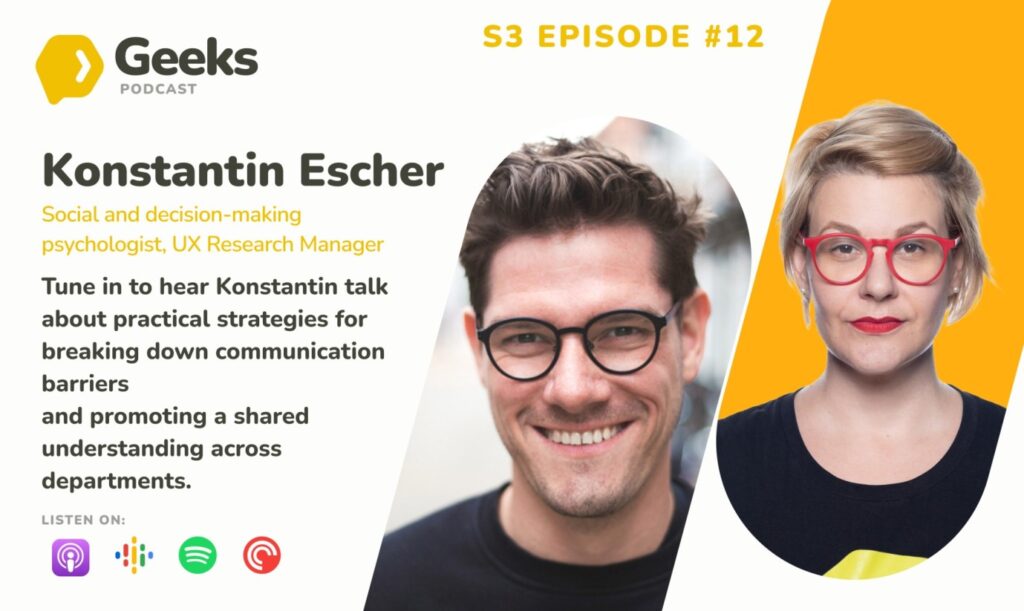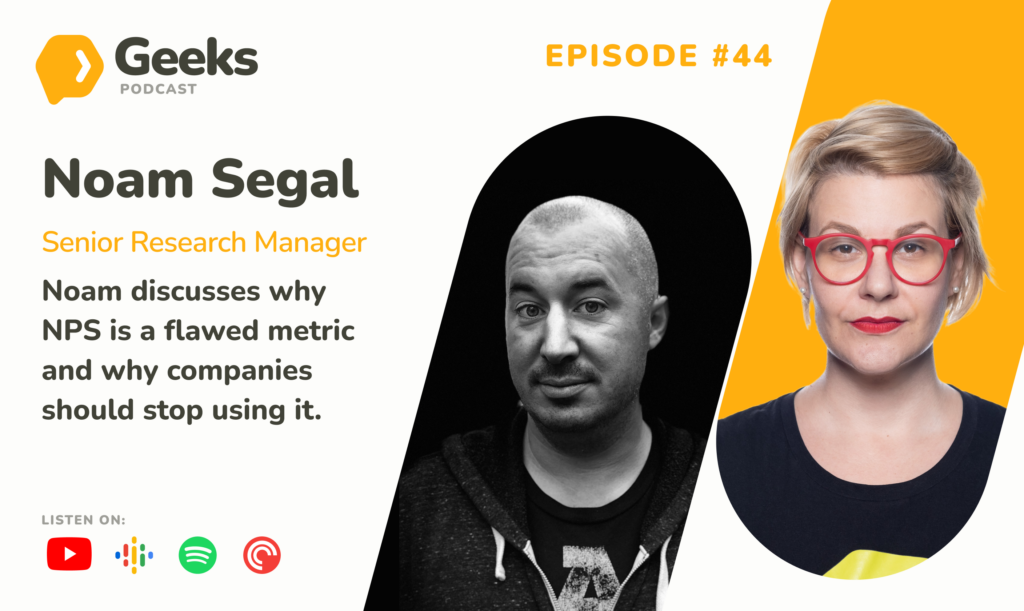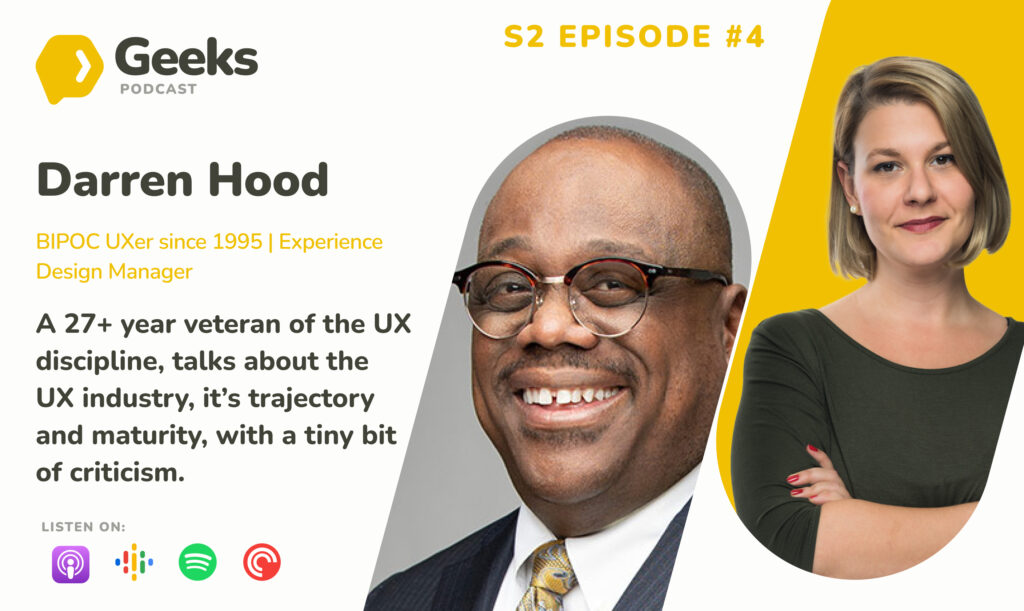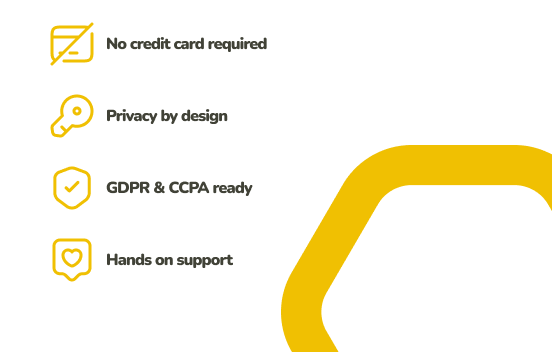👉 Join Tina on February 5th for an exclusive webinar where she shares her biggest takeaways from interviewing 50 researchers around the globe. She’ll reveal behind-the-scenes stories about how the podcast started, how guests and topics are selected, and give a sneak peek into what’s coming in 2025.
Did you miss it? No worries! You can watch it now here: https://www.youtube.com/watch?v=q91P9TqDq-c&ab_channel=UXtweak
Episode highlights
- 00:01:12 – Satyam’s journey into design and research
- 00:04:12 – Who owns research in companies?
- 00:07:10 – Why research belongs near leadership
- 00:13:31 – Explaining the need for research to clients
- 00:20:19 – Connecting research to business goals
- 00:27:26 – Insights from Satyam’s book
About our guest
Satyam is a leader in experience design, co-founder of UXReactor, and creator of the PragmaticUX framework.
Before founding UXReactor, Satyam led design teams at Citrix and PayPal, focusing on making design part of business strategy. An alumnus of Harvard Business School and Stanford’s Design Thinking program, he is dedicated to showing that great UX isn’t just about better products – it drives innovation across organizations.
Podcast transcript
[00:00:00] Tina:
Welcome to UX Research Geeks, where we geek out with researchers from all around the world on topics they are passionate about. I’m your host Tina Ličková, a researcher and a strategist, and this podcast is brought to you by UXtweak, an all-in-one UX research tool.
This is the episode number 52 of UXR Geeks and our guest Satyam Kantamneni. is a business leader who done it all. From UX research to design leadership to running a successful consulting firm, he basically redefines versatility. In this episode, we tackle the simple yet very deeply complex question, who actually owns research in companies?
Satyam unpacks why researchers should sit closer to the CEO’s office and why a researcher need to stop fighting for users and start thinking in business terms.
Tune in.
As per usual, we do it all with our guests. Who are you and what do you do Satyam?
[00:01:12] Satyam Kantamneni: So who am I? I, I actually am right now a business leader of a fairly successful design consulting firm in the San Francisco Bay area. I call myself a polymath because I’ve been, I’ve been very fortunate enough to have studied a lot of different lines of work.
I started my career as a electronics engineer, studied, and from there went on to study human factors engineering. And to be honest, I didn’t enjoy electronics engineering because the why of who you’re designing for, who you’re building something for was always missing. So when I studied human factors engineering, where how the human and the technology.
The human and the technology loop was very effectively understood, so I actually studied that from there. I became a user researcher. It was a couple of years that user research studying a lot of different functions. And this is again big back when there was no real user experience role user research role.
And technology, majority of the work was still in defense industries and then transition there. I went to a reasonable agency and then right when I finished my user research study, found all the insights. Unfortunately, we had attrition and then the lead designer left. And so I said, Hey, I know enough about the user.
Let me take a stab at it while we are recruiting someone. So transition and attraction design. I really enjoyed it because now you can take insights and do something with it. Felt like an inventor or felt like a cool guy in that process. Transitioned into interaction design with some research flavor into my next role.
I was recruited by a company called PayPal then to come and join their group in the San Francisco Bay area. And then took on the role of interaction design and design lead there, but then also helped build teams there. So I helped build an international team and the global center in India, really enjoyed building teams and building structures.
I did that for a few years and then was recruited by another technology firm to come in and build another team for, and so did that for six years, built whole research, design, interaction, all levels, hundred odd plus people. And then finally said, Hey, I’ve done 10 years working in corporate running design on design leadership, but there’s still a clear problem with the industry or this domain where you start looking at, it doesn’t really drive business value and insane business value.
Everyone still comes in and says, what do you do? Do you do this? Do you do that? And they had a very different understanding of the line of work. So I said, why don’t we drive business value by design? And when I say design, it’s a capital D design, which includes research. Interaction, visual, content, et cetera.
So ended up building a firm for, been doing that, leading it for nine years now. That’s who I am, who am I, what’s my background and what do I do right now?
[00:03:52] Tina: Thank you for sharing. And you came up with a very interesting thought. That I was like, yeah, this is it. This is it. This is what we have to talk about.
And, uh, the question that, that you brought up was like, who owns research in companies? And I’m wondering, what do you think about it? And why did you even bring up such a question?
[00:04:12] Satyam Kantamneni: I feel that this whole line of work is an adolescence, if you look at it in terms of maturity. I don’t think even we can clearly answer that, uh, outside.
So why is that an important question? Because There’s always the question of market research and user research. So market research is obviously owned by the marketing team. User research is owned by someone. Many companies even today don’t have a user research function, even though they are building products and features.
So effectively it is someone’s, somebody says I want research and that somebody could be a product person, could be an engineering leader. And so that kind of ends up becoming a role. Uh, and when they don’t have a, unfortunately, if you look at the design process, research is not a 24 7 line of work, and at least in terms of sequencing of work.
So what I can tell you, like, we had advised a company, a technology company, to bring in their researcher to constantly keep. You know, driving insights and building that stuff. Six months later, we realized that the researcher was doing design. Then research was like, it was not a luxury because companies, technology companies are built with armies of engineers, engineers need to work on something and to work on something you need screens and research, it does not really directly help any one of them.
Effectively research informs a lot of decision making. So that’s kind of a fundamental question. Where does the research live? And I have seen research live on the product. I’ve seen research live under design. If research is a function, I’ve also seen CEOs and within a mile here, there’s a billion dollar company that, you know, CEO, I kind of are having lunch with them.
And I asked him who does research for you. And his answer is my PMs to research. Period. There’s no research function. PMs are the researchers. And I’m like, so if they’re doing the research, then who’s doing the market sizing, who’s doing the requirements management, who’s doing that. So again, you’re overstretching that line of work, and therefore, when you do too many things, you end up being not good at anything and that’s foundationally where it is.
But that’s the foundational question. Who owns research? I actually believe that research. Now, let’s forget the whole technology industry. My fundamental belief is research is like intelligence. When any government, any system, when you have Intel, let’s say military, military has intelligence, governments have intelligence, the intelligence sits very close to the government and the context of a business, the government is the CE levels of a company.
That’s where research should sit at. That’s what’s informing them with what the users need, what the pains are, what the issues are. Constantly tracking and reviewing any of that data that’s coming in. It cannot be part of a function because then you only become as good as that function. And that’s foundationally what I would say is the way research should fit in.
But again, we’re talking about the maturity of the companies don’t even know research or understand research to the point that they understand it well enough that it’s actually a department of the CEO’s office. Okay. It’s a maturity thing, but I strongly believe it should fit in the CEO’s office.
[00:07:10] Tina: It’s an interesting thought because I’m always saying that we came from market research and we should be a holistic practice helping anybody because if I’m researching on a product, even especially in companies, which are digital marketing should know what I came to and inform them about stuff that is happening on their products and how to communicate it.
But how would you say? Should work this in your opinion, because this is my just very brief view on it. But okay, it’s, let’s say it’s under the CEO. How then does the, should the research be working and who should it be serving?
[00:07:48] Satyam Kantamneni: So I think it serves the company. And I actually, so one of the things is I also authored a book in the same line of work as how can user experience design the line, build profession, drive business growth, and it’s written for business leaders after studying a lot of businesses.
So one of the things is. A business is in the business of striving experiences. That means that giving the right users, the right experiences with the right. Tools and in this case, the technology to do that, you effectively need to bring the whole organization together. Now, user does not change department department for a business.
The foundational customer. The user is always going to be the same for that. You may build a marketing function for that. You may build a product function or customer success function or professional services function. But the user itself is not going to change, and which is why you need to think about that user and that user’s experience, and you can only think about it if you know what the user cares about, what the user’s pain points are, what the opportunities are for the user, why are they going, where they’re going, and if that data is not available.
Then the whole organization does not have the right information to work with. Which is why I keep bringing up the analogy of it being the intel. If the whole organization is a mission and it’s trying to play a war game here, it effectively needs to get that intel in a very effective manner and a consistent manner.
It has to tell you, like, where are the opportunities, where are the pains today, validating it consistently, have a lot of listing posts that you can get sensorial data around what’s happening at any given point with the users and their experience in the system. So this is a whole, it has to be a process, it has to be run by.
Uh, leader, and that leader could be a chief experience officer for a company, or it could be the CEO’s office, as I call it, the office, not the CEO, because the CEO is already stretched thin, and once, and that information has to be consistently propagated in the organization, everyone’s activated by it.
Now, I’ll give you a simple. Scenarios here, which actually manifest. So today’s world, we actually are highly diversified and distributed. So you have teams in Eastern Europe and India and wherever and Latin America working together for consumers that are maybe working in America or in United Kingdom, etc.
But the problem is many of these people have never come and stepped foot in these countries that the users live in. So that empathy is missing and not because they are not good people or they’re not, they don’t have the emotional quotient to do that, it’s just that they don’t know. And so that means it’s important for that data to know what is the journey of, let’s say you’re building it for Nurses and physicians.
What is that nursing nurses and physician journey in the context of let’s say NHS and UK or maybe a hospital system in America. So how do you take that data? How do you build that? So this is again a researcher’s job. How do you build that insights? How do you build it in a way that people can consume it and get empathetic to it now in the case where they don’t get empathetic with it?
What happens is the whole organization is just running with you. You told me to do this. I’m doing this. I got requirements from a PM. I’m building this, but without truly understanding what pain and what problem I’m solving for whom. And when that happens, your organization’s already becoming highly ineffective, which is why I say that if research was there, it constantly is looking at that.
Now, in this case, a researcher. All the research team would effectively say, how do I put this research insights into the onboarding process of every new employee that comes in? So they get highly empathetic to the data. See, because not only do you have to bring the insights, we also have to propagate those insights.
And I think that is where mostly many user researchers not do a great job of it. Here’s all the beautiful things. Here’s a beautiful report on this data. But that’s not where it ends. This data has to go to the right people has to constantly be communicated with them. And that’s the way that secret sauce is.
But again, that’s a elaborate answer to the point. Where should it live? What should it do? But it effectively is a important data set that had that kind of often gets lost under a department or so, which is why I strongly believe the higher it is. The better it is, but again, it’s the, when you get hired, that means you actually also need to treat that responsibility also with a lot of care that you don’t end up just talking about the details when the, when the forest itself has not thought through.
We’ll
[00:12:02] Tina: be right back after a short break with a commercial message from our sponsors. Hello, beautiful people. Hello, UXR geeks. This is Tina speaking. As you are listening now to this episode, there is a slight chance that you like it or like the podcast overall. So I would like to invite you for a webinar with me on the 5th February, where I will be sharing my biggest learnings from interviewing 50 researchers around the world.
I will be also talking about how the podcast started, how we choose our guests and the topics. And what’s coming in 2025, it’s going to be a lot of fun. So sign up through the link in the description.
I really love what you’re saying and framing it as the Intel, because the Intel is actually what could make a big difference, but I’m also wondering coming from the mention of. As in the field being in a age of adolescence and you talking about this is a little bit like me to level and hearing this or strategic level of approaching research and do doing research and delivering with research but i’m wondering how do you go about with clients who don’t have a research or a very.
New to the area, just starting out and how do you make sure they understand why they need that research and why they need researchers. A never ending question, I know.
[00:13:31] Satyam Kantamneni: No, it’s actually simple in some ways, and it’s also stupid in some ways. Well, in a lot of ways, because it’s a simple question, right? The simple question you ask any leader is, do you know your top users?
Do you know their top pain points? Do you know what you’re doing about it? And do you know how You know, you have solved it when you have solved it and that fund, that four questions effectively will let whether the organization knows its users, knows the pain points activated around it and are measuring around it.
And now if you do that with four or five people across the company, you’ll also realize that they are not all thinking the same thing. So this is where the inefficiency is. Now, first question, do you know who your users are? If everyone’s answering different things, that means you don’t have cohesion around that.
That, again, is a researcher’s job. If you know what the pain points are, then, you know, what exactly, and has it been communicated across, or some people get it, some people don’t get it, then that has to be, again, communicated. Are you doing something about it? So, someone has to curate it and track it. So, a researcher is, again, as I say, you could be the person that says, I’m going to give you the data.
It’s Do what you have to do with it. That’s a researcher that’s driving out outputs. A researcher that takes that data and says, I’m going to make sure that the right people know it, understand it, and register it. And they’re acting on it. That is an outcome focused researcher research itself as a function is effectively bringing the insights.
That’s what the profession does again. I’m not saying you have to have a researcher. If a PM can do a good job, let the PM do a good job. It’s a mindset before it’s a skill. So you have to constantly be saying, who are my users? What are the pain points? What are their issues? You extract that data. And kind of communicate that now, if you can do that effectively, it’s great.
But it’s also a very method based process. One of the things that I often say is there’s five ways to screw it up. You can, I can ask the wrong users, the wrong questions, synthesize it the wrong way. And then communicated the wrong way. So there’s so many ways to use the wrong method. There’s so many ways you can screw it up.
Therefore, you need a professional to come in and do that. Now, again, the same way, can I not do surgery on someone? Absolutely. If I watch enough YouTube videos, I can at least attempt it. I’m going to be the best surgeon. Probably not, which is why you need professionals to come in and do that. But the sense says, yes, we all self treat.
And in some cases we can, most cases you want to leave it to the professionals.
[00:15:51] Tina: And now I’m going with the loop back to what you said, that user researchers are not really good, uh, in propagating or marketing research. And this is where, just before we met, I was scrolling my O’Sullivan was mentioning this one as well, and I am always saying the researchers are sometimes too humble and not too marketing ish and you have to push it in your faces, the insights, but address it to the right people.
That’s the principles are. Clear but what would you say is really the right way of propagating and making sure that the research is or the insights as the delivery is really impacting the business.
[00:16:35] Satyam Kantamneni: I’ll frame it as, you can be humble and, and we all should be, the big thing is how much conviction do you have and on data you have.
I often tell many of my researchers that I get the opportunity to mentor and coach. I say, go watch the movie Zero Dark Thirty. It’s the movie that was created by, by Hollywood and on how they took Osama Bin Laden down. And that’s the whole dramatization of that. And I say, who’s the key character there?
And it’s interesting, if many people who haven’t watched the movie, even if you watch the trailer, there’s actually an intelligence agent, a woman who actually sits in place and is looking at connecting the dots. So that’s most researchers, you’re connecting the dots, you’re sitting there, you’re looking at what, what’s going on, et cetera.
But what she did with it was way more important. She actually, as a junior person in the organization and the whole hierarchy, she stood up for her conviction, said, I see this data. I register this data, and I need to do something with it. So that that has to come from your own heart, that when your users are entrusting you that data to you, you have to make sure that it comes together in the right place.
In that case, in the movie, she actually stood up. She stood up in a meeting and in many senior members and said, I believe where Osama Bin Laden is, and I think I, I have data and, and I can prove it, and this is what’s going on. I need support to do this. And that’s the same way as, as, again, I’m hasn’t been, it doesn’t have to be as dramatic, but the sense is you have to believe that you have the data and need to propagate it.
The simple techniques you could, uh, print out the data and present it to more people. You have to repeat the presentation multiple times. It’s okay. Don’t get disheartened with that every time you present it, because again, there’s a difference between listening and registering. If people listen to your data, they absolutely will agree with you.
Registering means that this data is important and I’m going to do something with it. And that’s what you need to activate consistently. Again, most times people are not sure about their own data. They’re like, they start second guessing themselves saying, ah, the sample wasn’t good. Oh, actually, I think maybe it was me who asked the question wrong.
And that’s kind of where it is. Again, if you’re a good researcher and you’ve gotten good data and you have conviction around it, it automatically, that energy will. So to talk to the right people, engage with the right people, share more often, have open houses to talk about the data and the users. As I said, bring that users to the every new employee when they join being part, make it part of the process of every new employees onboarding.
So these are subtleties that you have to think about. It’s again, it’s a design problem of thinking, like, how do I take this data and make sure that the right people have it at the right time at any given point? And that’s also a problem of a researcher that has to think through. Otherwise, if you just say that it’s a good report, my immediate team gets it.
And I’m done. I’m going to move to the next research study. I think we are doing a disservice to the smartness and the hard work that has gone in by us as researchers and the profession overall.
[00:19:22] Tina: Here I am very curious about your book because you are writing for business leaders about business leadership in our field.
And I’m wondering, in your opinion, how a researcher could become such a business leader? Because one thing is the role. And you just said how to do it and how to spread it and how to work for it. But I know a lot of research, and this is something I get a lot from the field, and especially, it’s not really the best time in the business where people get laid off, and research was one of the first departments to get laid off, where people don’t feel heard, don’t feel seen, even if they fight as lions for users, for their insights.
So, I see the big step from coming from a researcher who is fighting at the table and trying to make an impact in the company to becoming a business leader who really can vouch for this impact.
[00:20:19] Satyam Kantamneni: So i’ll actually share a couple of things before i talk about the business side. And I think this is a very important lesson I’ve learned in my own career.
You understand the user, but you don’t fight for the user. You understand the user, you understand the insights, but you fight for the business. And the business, and that’s where the disconnect is, that we should not say this is good for the you. When you’re talking to business leaders, And in that aspect, you’re not talking about the users.
You’re talking about what that users will impact to the business. For example, if a business is talking about where should we strategize and invest time and the next line of work, or which product do we pull together? Which service do we invest in a researcher could come back and say, Hey, I’m seeing all these areas where users are using Unintended users are using our product in unintended ways, and we can probably look at how that is.
And this may each be an opportunity by itself. Now you’re talking business language with user data, and you’re not fighting for the user. You’re fighting for how the business can make money. The same way is if a company is looking at M. N. A. You’re looking at how would this help? How this integration process work together for the same user?
Now you’re bringing user data into a business conversation. So you need to be comfortable in having those business conversation. You need to be able to make annual planning conversations. You should be able to make budgeting conversation. You should be able to look at M. N. A. Conversations and then bring in the data in the right relevant manner.
[00:21:49] Tina: Just sorry to interrupt you, but what is the acronym stands for M& A
[00:21:54] Satyam Kantamneni: merges and acquisition.
[00:21:55] Tina: Okay,
[00:21:56] Satyam Kantamneni: great. Absolutely. So we have the data and we bring in that data in the context of business. That is the most important. Now, how do you become a business leader? You become a business leader by talking business.
You start looking at a business leader by understanding the variables of business. Any businesses making money or saving money. That’s the foundation of every CEO. That’s where you’re spending your time thinking through. How do I make more or how do I save more? And so you have operational aspects to it.
You have opportunity aspects to it. Innovation aspects to it. Now that’s the conversation you want to have. You’re not having. Hey, are my users going to get screwed? That’s not the conversation. That’s the back end of it. You have taken the data, you have transposed it into what’s a business need for that, and then talking about that user and that user’s thing.
When you say if this product will get shipped and you effectively will have more return rates with this user because there’s more friction points, you’re talking about return rates. You’re not talking about user pain. Uh, and that’s what the business cares about. So again, you’re, you’re talking to people and that’s the same thing as listing and registering.
A business leader will register. Oh, I do not want more returns because every return is effectively is selling 15 products, that’s what it is. Every bad review is like losing 30 new sales. Now that I need to focus on that. So you’re registering that and that’s how you’re engaging and collaborating. So that’s the first part.
I actually strongly believe a good researcher makes an awesome business leader. And the reason a good researcher and a keyword is a good researcher because they can take data, they can understand how it connects to a business and they can inspire people to make that work and that makes you understand the business part.
And then if you’re inspiring people, that makes you the leader part. And effectively, if you can build a system of around it, then you effectively are the only, uh, you’re become a very good business leader to drive whatever you want to drive. And I’ve seen this work actually in a lot of ways. I’ll give you an example of a person that I know who was a product manager.
And while I was working with him a long time back and one of the jobs I was doing, we had introduced the concept of journey mapping and defining what the journey and the pain points are. And we did an extensive job at that firm. He left and joined another firm at that point as a head of product there.
And the first thing he said, as soon as he joined the firm, he said. I’m going to do a journey map. I’m going to define where the users are, where the pain points are. So I can plot all the data in a single place of, from all the sources, from customer success, customer support, our user research into a single user journey.
And then I’m going to plot that data. He did that. That was his first three months. He kind of got his old team activated because in his mind, he was like, what exactly is going on? Let me plot it out. He plotted it out and he had a board meeting. He took that plot, he shared it with the board, and then it said, this is where I think the business is going, this is where the users are, this is where the user issues are, this is why we are, we have more return and more churn, et cetera, et cetera.
By the time six months was done at his tenure, he was made the CEO of the firm. Right now, this is as simple as that. If you can articulate what you’re doing again, it was very smart. He was a product guy, etcetera. But the fact is, when you can start activating, you start understanding what the pains are, and you can articulate that others look at you as like you have the answer.
Can you go and do it? And that’s foundationally again example. Now, again, in this case, the PM did a research method, but effectively anybody can do that and can lead with that.
[00:25:15] Tina: And going back to the initial question, who, who is owning research? I am wondering what the researchers should be owning from what I heard from you is owning the business language, owning, not fighting for the users, but fighting for the inside and for the business.
I love also, if we emphasize. and empathize with our stakeholders. Is there any more things that you would say that researchers should be really, and yeah, it’s a little bit of a slang approach, owning, that we didn’t talk about?
[00:25:52] Satyam Kantamneni: I think being a researcher, to be honest, is a hard job because it’s highly ambiguous.
You’re trying to make something out of A lot of ambiguity and then inform people and then let them know that, you know, go make something with this data set. So it’s already a hard profession to start with. Uh, I would just say focus on the things that you do. And again, I have five things I’ll, I’ll talk about.
Understand, own a user. Own a persona or a user and then keep to that user till the time you are in that company. Be that person that actually knows and understands that you have all your, you have all the methods to extract data and insights for that user. Once you have all those insights, then you effectively are synthesizing it in ways and artifacts.
Sometimes you may have to create a few. Then you are constantly presenting it there, uh, that to the right people. And then you are propagating that. So again, owning that process and also owning the system around doing this. So making sure that you have the consistently doing it faster, greater, better, because one of the myths that come with this line of work, Oh, if I bring a new researcher and it’ll take me months, what it’ll take now, I can make a decision and in weeks, or it’ll take me days when I can do a decision in weeks.
Uh, so in days, uh, so it’s. That’s one of those issues that you don’t want to resolve. If you can just own the user and the data and then how that comes together and then translate it for the business leaders or engineering leaders or whoever it is, it effectively itself is going to be a great service to the profession as well as for the role in the firm.
[00:27:26] Tina: I really like how you paint it well. And brought together the kind of user researcher journey in a company by this few points. And by emphasizing connecting the dots, is there anything else that you want to mention coming from the book? Because I’m really interested in that one. Why our listeners should maybe have a look at it.
[00:27:51] Satyam Kantamneni: No, the book itself, to be honest, was written for business leaders, but again, serviced by practitioners like ourselves,
[00:27:59] Tina: right?
[00:28:00] Satyam Kantamneni: We effectively, as we supported a lot of business leaders and. In our career as well as in our, my tenure at UX Reactor. We identified 27 different place of that business leader struggle with, and then we broke it into four sub themes.
One of them is research. And so we effectively said, you can then team one was experience strategy. How do I drive experience strategy in a firm? And then the second thing was how do I actually do level of research to inform that strategy? And the third was product thinking, which is like, how do I now bring this into.
Acting on it and then the 4th one was designed doing is actually getting into the details of the design and implementing it. So those are in between these questions. Let’s just talk about research. Like how do I recruit the right users? How do I? communicate my results. How do I build an empathy score for my whole company?
How do I measure the experience metrics? So these are all things that kind of the how do I questions that we extract and we wrote that up. So again, it’s a book that talks about that you experience economy is here and it will stay a product today will not be successful if you just build a feature functionality without thinking about the journey and the experience of the different users.
Uh, and, and to bring that data, you need the researchers, you need the designers, you need the, uh, strategists to coordinate and, and orchestrate that. So effectively, that’s what the book is about.
[00:29:20] Tina: Thank you very much for your wisdom. You said many things that I maybe somehow heard a lot of things. I completely agree.
It’s not about agreeing or disagreeing, but I feel like, okay, you said it out loud. I like it. And I thank you for how you frame the things and reminded us of our practice and coming back to the business. Thank you very much.
[00:29:41] Satyam Kantamneni: Absolutely. Thank you. I appreciate your awesome hosting today.
[00:29:49] Tina:
Thank you for listening to UXR Geeks. If you enjoyed this episode, please follow our podcast and share it with your friends or colleagues. Your support is really what keeps us going.
If you have any tips on fantastic speakers from across the globe, feedback, or any questions, we’d love to hear from you too. Reach out to geekspodcast@uxtweak.com.
Special thanks goes to our podcast producer, Jana Filušová, our social media specialist Daria Krasovskaya and our audio specialist Melisa Danišová. And to all of you. Thank you for tuning in.
💡 This podcast was brought to you by UXtweak, an all-in-one UX research tool.

















